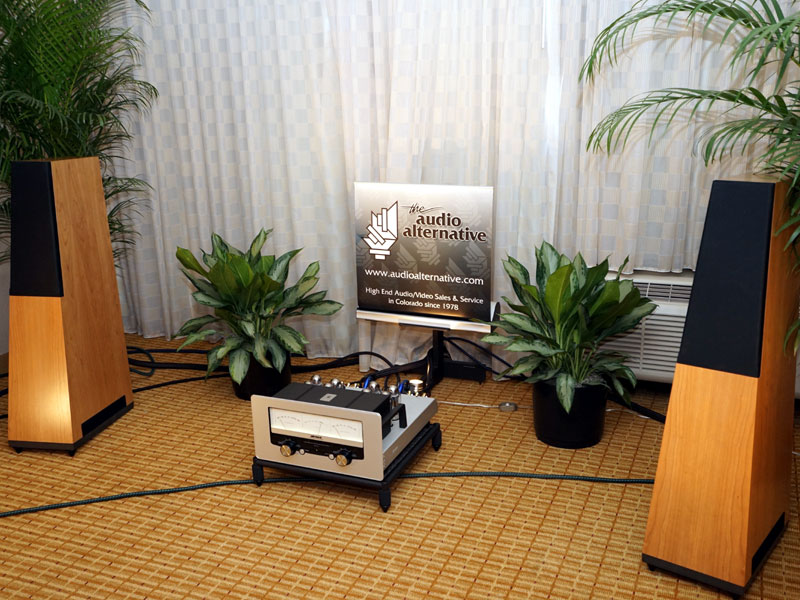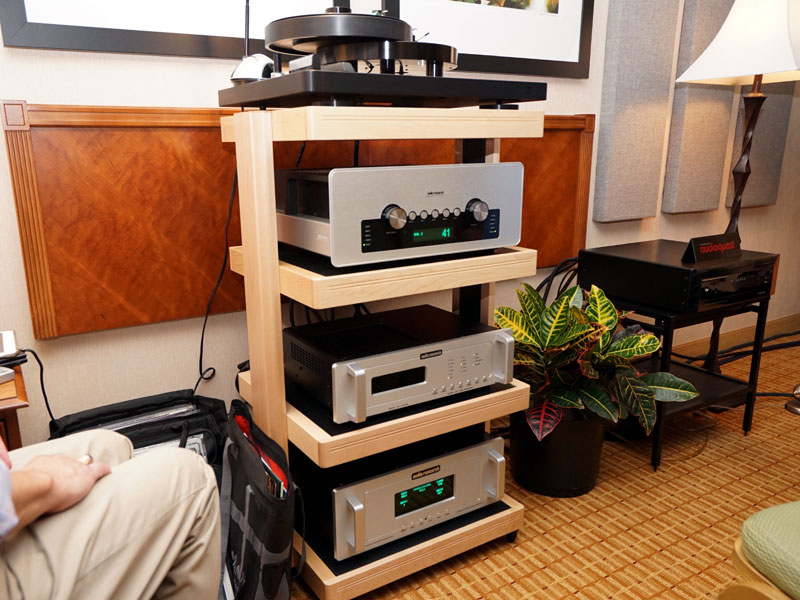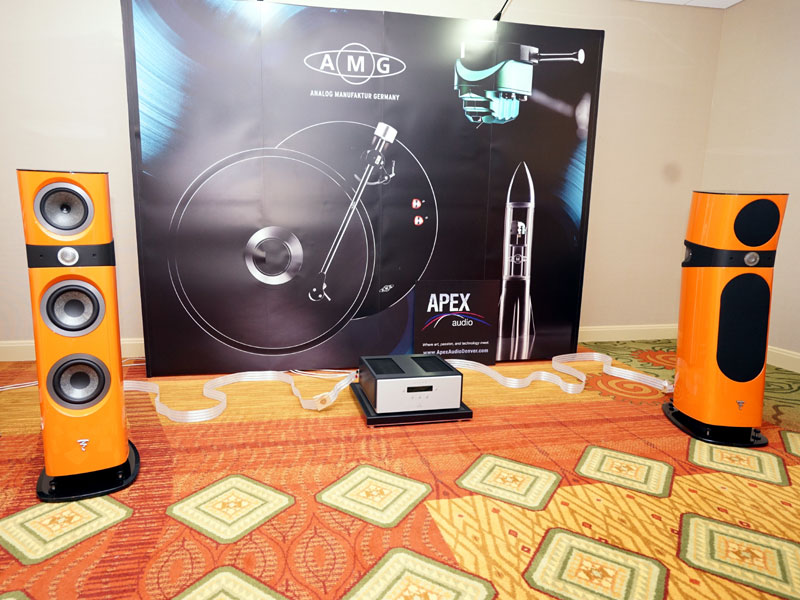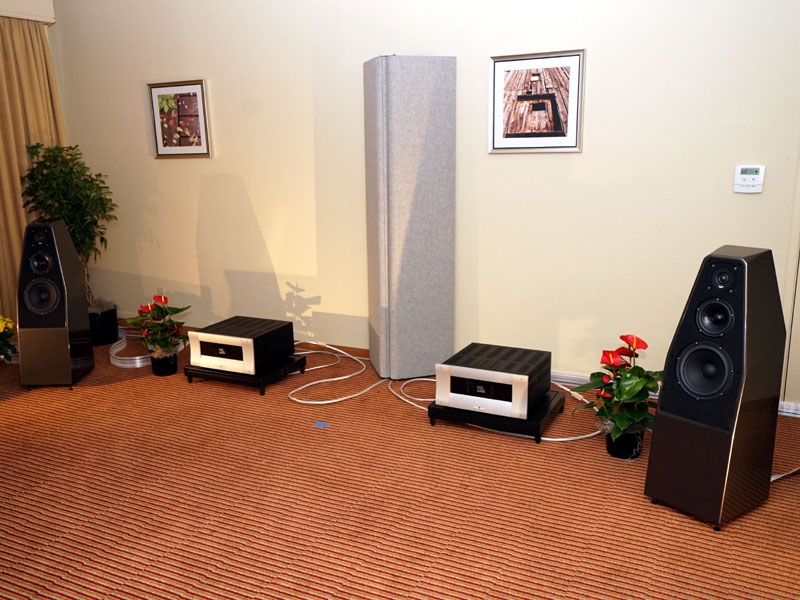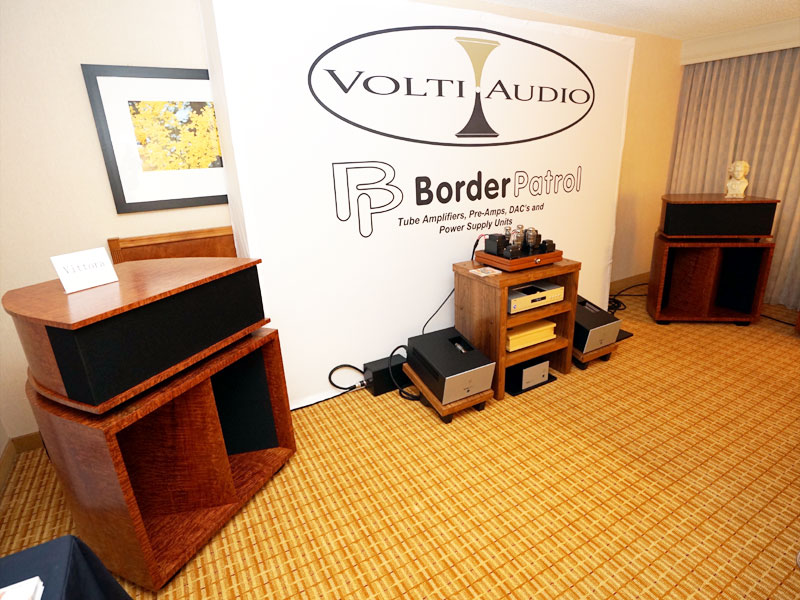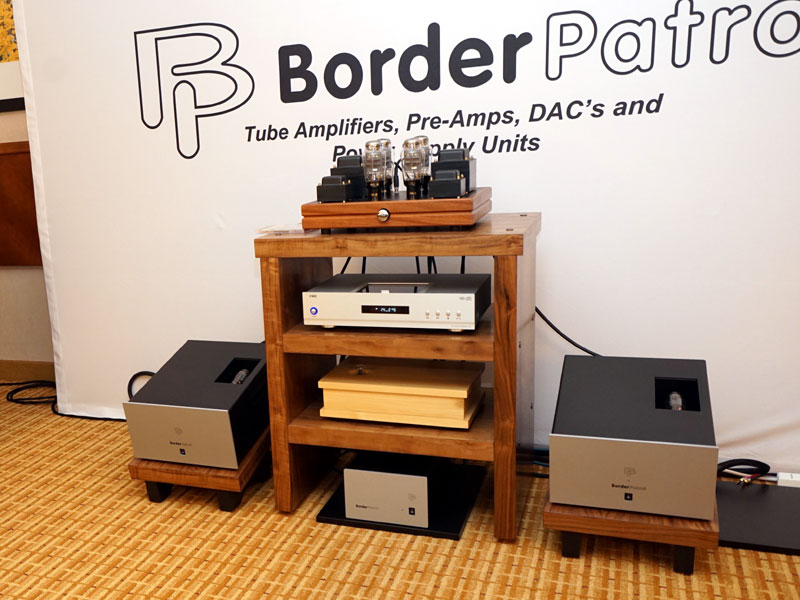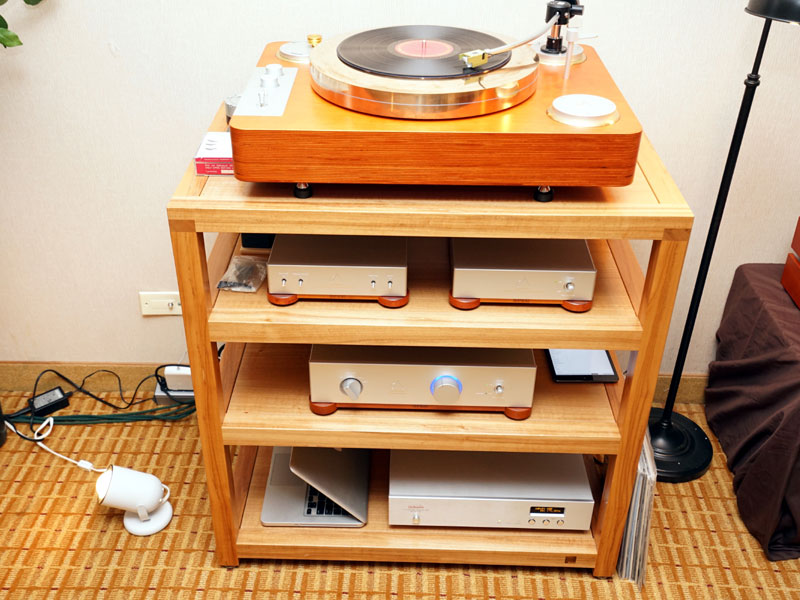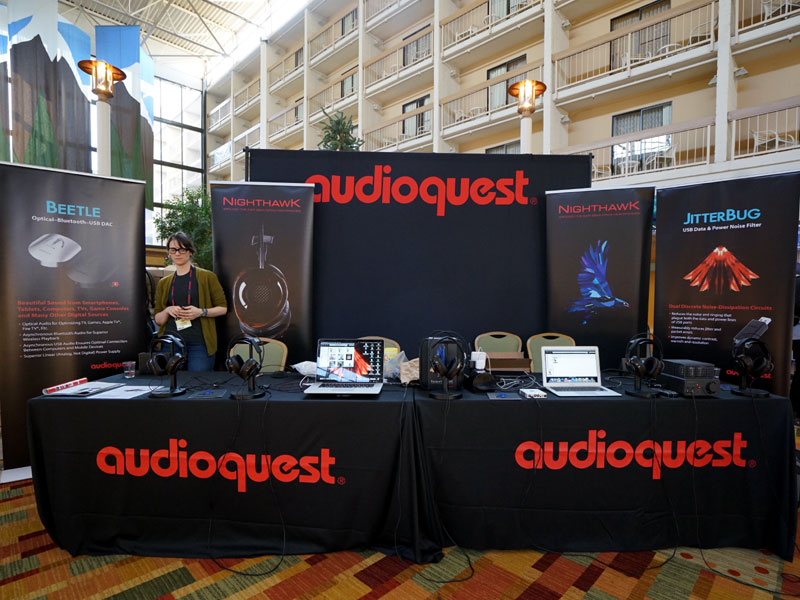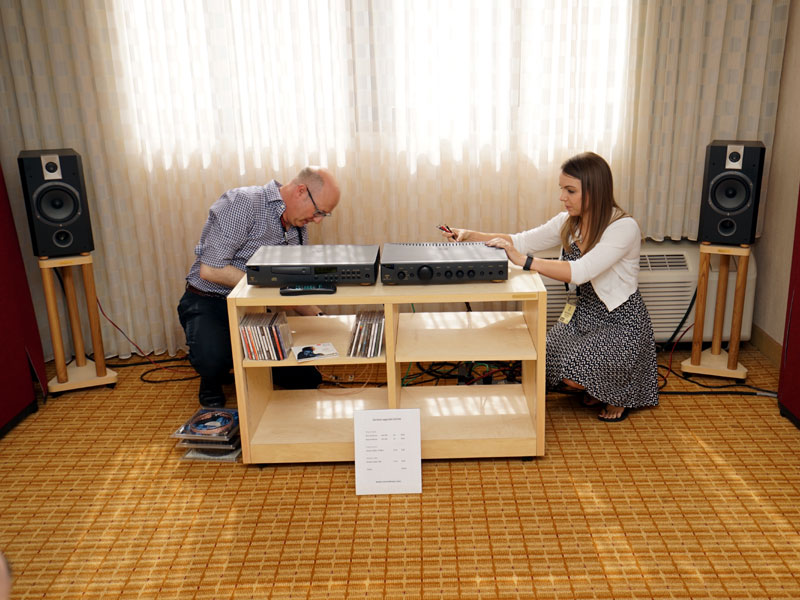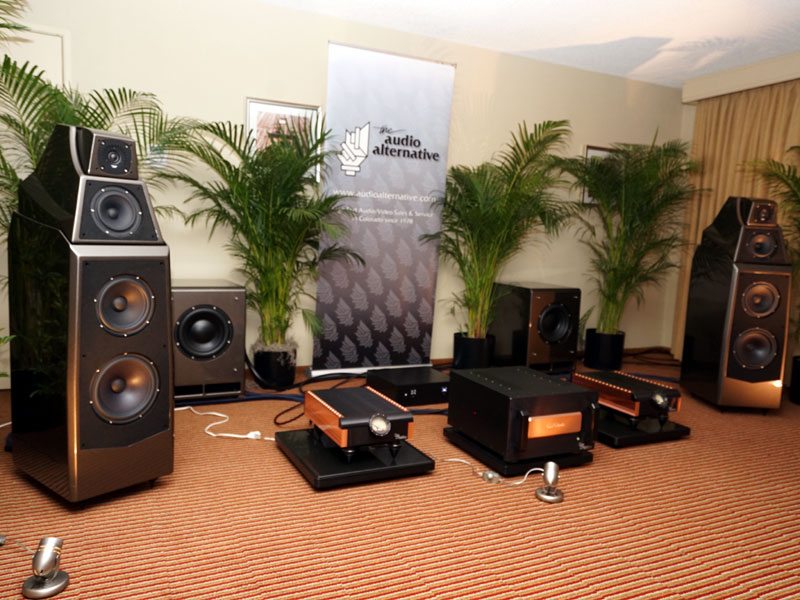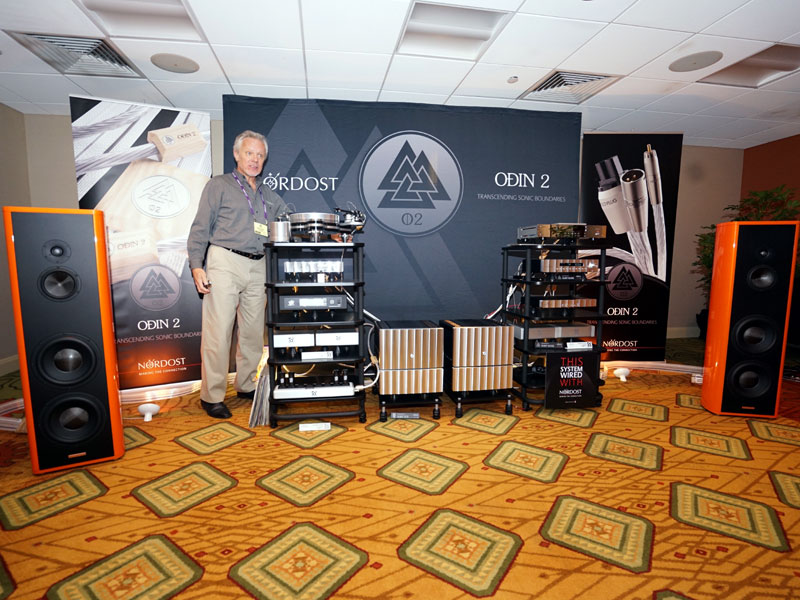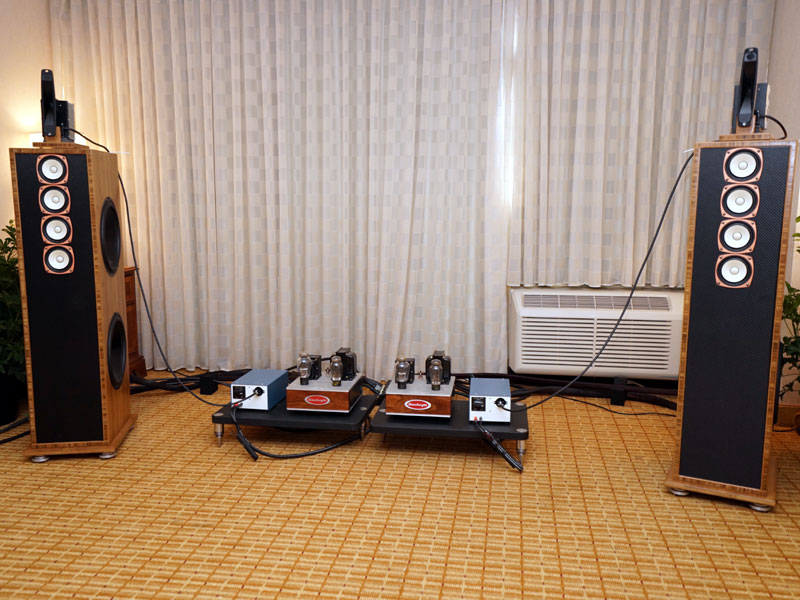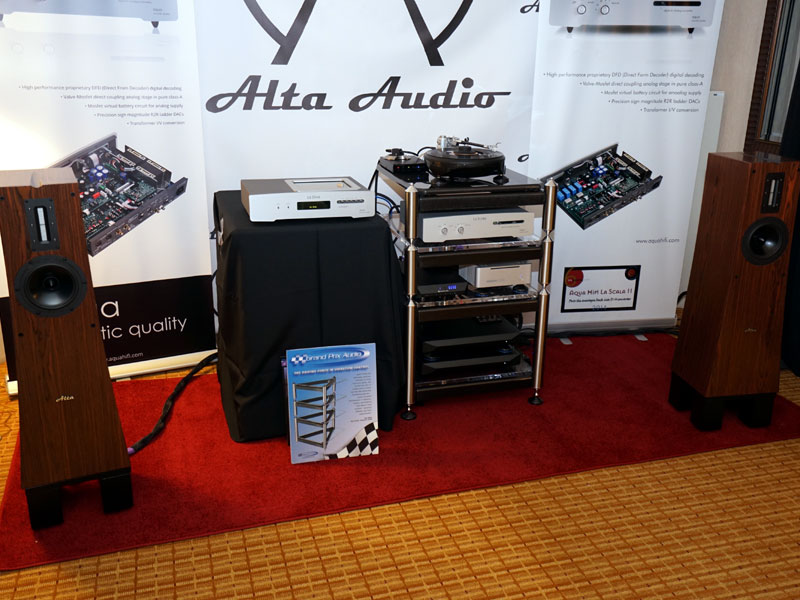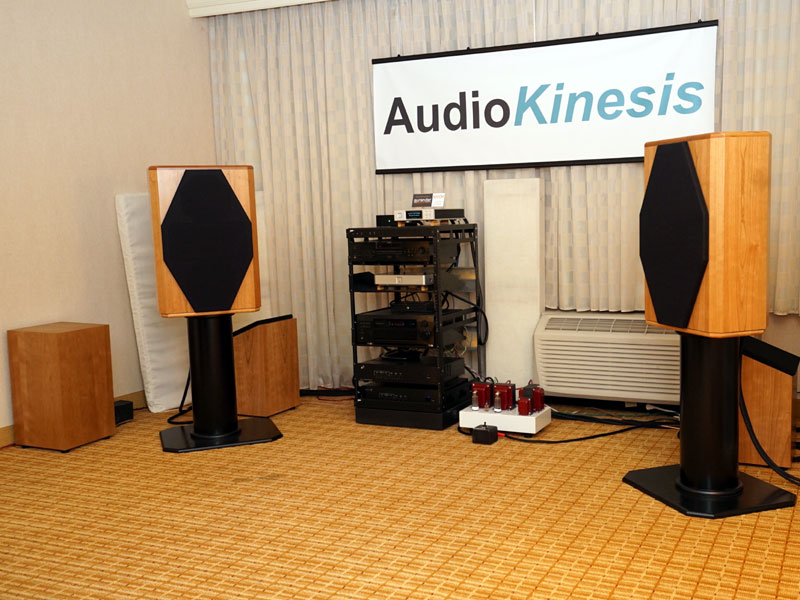Rocky Mountain Audio Fest 2015 • Reduction and Redemption
nother year and another Rocky Mountain Audio Fest (RMAF). While all shows retain a character -- and this one more than most -- there was a clear evolutionary trend to this year’s exhibits. While long-established partnerships have carried over, year on year, more than one of the show’s premium pairings demonstrated more modest, more manageable and (whisper it under your breath) more affordable systems. Nowhere was this more apparent than in the case of what have become two of the show’s principle players, with high-profile product launches and high-end systems regularly vying for "best of show" honors. Both VTL (in conjunction with Wilson Audio) and Audio Research/Vandersteen showed far more approachable systems than in recent years.
Starting with the latter, local dealer Audio Alternative employed a combination of Audio Research Galileo- and Reference-series products to drive Vandersteen’s Quatro Wood CT ($14,895/pair including crossovers), a rare outing for what is the unsung hero, biggest bargain and should be the biggest seller in the Vandersteen range. Sharing the same basic topology, high-pass crossover/equalized active bass and carbon tweeter as the Model 7 Mk II, all crammed into a slimmer and simpler cabinet, the Quatro Wood CT sells for around a quarter of the price of its bigger brother -- making it an awful lot of speaker for the money, whichever way you look at it. The system was relocated from the large room used for the Model 7 Mk II based-systems we’ve loved so much at recent RMAFs, to a standard bedroom setting, where the Galileo GSPre ($15,000), GS150 power amp ($20,000), Reference Phone 2 SE phono stage ($13,000) and CD6 CD player/DAC ($9000) were paired with an AMG Giro G9 ‘table/9W2 tonearm ($9900) and Teatro cartridge ($2750). Support was an HRS RXR stand with shelves to suit, while cabling was provided by AudioQuest, including the brand-new Niagara power conditioner ($7995), hardly bargain basement but modest by the standards of previous Model 7 Mk II-based setups.
Smaller system, smaller room, same great results is a succinct summation of this setup’s impressive performance. The sense of substance, presence and power was extremely impressive; if the test of a good audio system is whether or not it sounds like real people playing real instruments, then this system passed with flying colors. The music was lucid, refined and articulate with real immediacy, impact and rhythmic urgency. Playing the test pressing of Intervention Record’s upcoming Joe Jackson I’m The Man re-release, the setup delivered all the punch, power and drive that characterized the original, but uncovered hidden subtlety too, from the carefully layered backing vocals to the natural communication and surprising quality of Jackson’s lead vocals. What was always an album full of excitement and attitude now reveals hidden and unexpected musical and emotional depths -- depths that the Audio Research/Vandersteen setup was only too willing to plumb, while still preserving the affecting bitter-sweetness that informs so much of Jackson’s music. To deliver this much musical power, control and insight in such a confined space was particularly impressive, while smaller-scale and more intimate music was treated equally effectively. As I've said, the Quatro Wood CT deserves a much higher profile, and following this show expect to see it featuring more regularly in Vandersteen presentations. This has to be one of the biggest high-end speaker bargains out there, and with more audiophiles facing contracting budgets and more dealers seeking more affordable solutions, this outing served as a timely reminder of just what the Quatro Wood CT can deliver.
Another downsizing operation was in evidence in the Musical Surroundings room. Two years ago it was Focal Stella Utopia EM, last year it was Scala Utopia V2 and this year it's the Sopra No. 2 ($13,995/pair), first seen at this year’s Munich show, this stylish floorstander slotting in below the Utopia models. Maintaining the theme, the driving system was downsized too, with an AMG Giro G9 record player ($9900) and a Clearaudio Ovation/Magnify ‘table and 'arm ($9100) carrying a DS Audio DS-W1 cartridge ($8500) acting as sources, feeding Aesthetix electronics (a Calypso Eclipse line stage ($10,000), Rhea Eclipse phono stage ($10,000) for the AMG Teatro) and a Romulus Eclipse CD player ($13,000). But the big story was the arrival of the new Eclipse version of the excellent Atlas stereo amplifier ($15,000), completing the Eclipse family. Featuring Stealthcap capacitors, improved signal grounding and advanced mechanical isolation of the chassis and power supply, the Eclipse series promises blacker backgrounds, improved resolution and faster transient response. It’s hard to say just how effective those upgrades are without recourse to direct comparison, but this system was certainly super crisp, clean and dynamic, the Sopra No. 2s defying their compact dimensions to deliver serious levels and extension. Using Critical Mass racks and Nordost Valhalla 2 cables throughout doesn’t hurt, and this was a system that achieved considerable musical coherence and dynamic integrity -- even on Metallica. In another welcome trend, Musical Surroundings weren’t the only room playing real music, even if it wasn’t to everybody’s tastes.
Meanwhile, it was situation normal at VTL, where great music and great recordings so often seem to coincide. This year’s system took a step down on pretty much every front, a decision possibly driven by room partner Wilson Audio’s decision to employ their petite Sabrina, the smallest and most affordable floorstander in their range. Weighing in at $15,900/pair, this was the third of this intriguing trio of real-world designs from companies perhaps better known for their designs on the highest end. Electronics were VTL’s TL-6.5 Series II line stage ($15,000), TP-6.5 phono stage ($12,000) and MB-185 Series III monoblocks ($17,500), with sources including a Brinkmann Spyder Turntable with 10.5" tonearm ($24,600) and Lyra Etna cartridge ($6995) as well as the dCS Rossini one-box CD player ($28,499), joined by the new Rossini Master Clock ($7499). Reflecting the increased awareness of the part played by system infrastructure in overall musical performance, support was once again provided by HRS (SXR stand, RXR stand and platforms) and this was one of many systems wired front to back with Nordost’s new Odin 2 flagship cables, a wire that seems to be taking reviewers, dealers and manufacturers by storm -- even those who evinced suspicion of the earlier Nordost designs. Judging both by the buzz at the show and the performance of the systems using it, Odin 2 seems to have seriously nailed it. Mind you, so does the Wilson Sabrina. Widely set in the large room, the smallest Wilsons still managed to generate the company’s trademark soundstage, dynamic impact and dimensionality, and even shorn of the Spiral Groove ‘table (not to mention the four-box dCS Vivaldi digital rig) used last year, the system still managed to impart significant musical authority, solid imagery and a sweet and articulate overall balance -- doubtless helped by the EL34 output tubes employed in the MB-185s -- modestly priced models in a stellar range that, like the Vandersteen Quatro Wood CT, deserves a wider audience and more elevated reputation. Here, it did sterling service, driving the Sabrinas with an easy grace and intimacy that made for compelling listening. The Classic Records reissue of the Heifetz Sibelius Violin Concerto was characteristically rich and sumptuous, but what was really remarkable was the sense of musical scale and power generated by a system that seemed dwarfed by the room it was playing in. This was a sound that stepped right away from the speakers, filling the space and height of the room, not just its width, and despite the wide stance of the speakers there was no hole in the middle or loss of substance on vocals or soloists. Anne-Sophie Mutter’s Carmen Fantasie was typically incisive, exhibiting both poise and attack, while Montserrat Figueras’ voice was glorious in all its luminous beauty. This system might give ground to bigger VTL/Wilson rigs in terms of absolute scale and dynamic authority, bandwidth and maximum level, but it doesn’t give an inch in terms of musical integrity, underlining once again that not only is the Sabrina fast becoming a key speaker in the Wilson range, but that has in turn re-energized interest in this $15,000 price point. Judging from the three systems I’ve mentioned so far, that can only be a good thing.
If VTL/Wilson, Musical Surroundings and Audio Research/Vandersteen are always a safe bet for decent sound (whether at RMAF or anywhere else), then the Volti/BorderPatrol room constitutes a home banker. Déjà vu barely covers the sense of familiarity that greeted one’s entrance to the presence of those curvaceously retro horn cabinets and the improbable stack of tube electronics doing the driving. It was almost as if the system had been left in situ from last year, quietly settling down and settling in. I know that’s not the case, because Gary Dews from BorderPatrol and Greg Roberts from Volti Audio both complained individually about the issues surrounding transporting and installing the other’s products ("Crates that use ten screws where two would do! He reduced the total number by 28% and there’s still over 140." or, "Each year the boxes seem to get smaller and even heavier! My boxes might be big but at least you can lift them.") Don’t worry -- it’s exactly the sort of bickering you’d expect from an old married couple, and in audio terms at least, that’s exactly what they are. I’m not sure how long they’ve been exhibiting together, but the parts of this system slot together so comfortably that it seems like it’s been forever.
Despite appearances, there have been a few developments since last year. Closer examination revealed a volume knob (backed by an additional gain stage) turning the BorderPatrol S20 EXD EXS into a true single-input integrated amp ($25,750). There was also a CEC TL-3N transport ($2250) in place of the Tent Labs, a modest machine for which I have a seriously high regard. This was feeding the BorderPatrol DAC1 ($9750 -- filterless implementation of the AD1865 chip set, using a 6SN7 output stage, Dueland CAST coupling capacitors and a massive external tube-rectified, choke-input power supply). Meanwhile, this year’s Volti Vittora five-cabinet speaker system ($25,000 including the active ELF subwoofer) sported beautifully executed and extremely handsome quilted bubinga veneers. The in-house rack had taken a step in both height and appearance too, lifting the source, amp and power supplies clear of the floor for a newly elegant presentation. It was almost as if those subtle, aesthetic touches had transferred to the products themselves. Laced together with Triode Wire Labs cables, this system had all the effortless power, scale and dynamics, natural presence and immediacy of years gone by, but now with an added degree of dynamic discrimination, textural nuance and overall integration. Even on day one, this system sounded super-settled, grounded and musically coherent, able to rely more on intimacy and low-level articulation, less on its more obvious attributes to transmit the musical message. Acoustic guitars had wonderful attack and decay, string tone and instrumental body, while voices were breathy, communicative and direct. I don’t know -- maybe it was all a scam. Perhaps they really did just lock the door last year, leaving the system playing until 2015 rolled around. Could be -- ‘cos that’s the way it sounded (except that I know Gary, I know where he comes from and I know that he’s way too tight to pay for the room). All kidding aside, this system just seems to go from strength to strength. It was a pleasure the first time I encountered it and it has gotten better, year on year. US readers (especially the horn aficionados) should count themselves lucky: Volti Audio’s direct sales model makes this not just one of the most enjoyable and easily accommodated horn systems on the market, it’s also one of the most affordable. Combine it with the BorderPatrol amps, electronics that truly demolish the notion that all single-ended tube amps are necessarily limp-wristed, and you have a recipe for musical experiences that are long on emotional intensity and lifelike presence, serious scale and neighbor-worrying capabilities, all at a price where all too often more conventional systems are having to trade on finesse rather than musical impact, never less than polite where they really should be spitting and kicking. Visiting the Volti/BorderPatrol room is always a pleasure and never less than real.
One of the most intriguing systems at RMAF was to be found in the Designer Audio room, pairing a SPEC turntable and electronics with a pair of DeVore Fidelity Gibbon X loudspeakers (around $12,000). The latest Gibbon adds a much more powerful motor to the familiar 7" midrange unit and augments that with a pair of horizontally opposed, force-canceling 8" bass drivers, all bolted into a solid bamboo cabinet. DeVore claims a bandwidth of 22Hz to 40kHz, although no ± limits are quoted. Impedance is non-reactive and hovers around 8 ohms, while sensitivity is stated at 92dB. Those are impressive numbers, but what was more impressive was the effortless integration and easy, expressive sound of this system. It really allowed the music to breathe -- which is all the more remarkable given that the beautifully presented SPEC RSA-M3EX 60Wpc amplifier ($9500) is a class-D design, not a topology generally recognized for microdynamic definition and temporal integrity. The source was SPEC’s substantial GMP-8000EX, a massive slab of laminated birch ply topped by an equally massive, thread-driven 16" oversized platter and 12" EMT tonearm ($25,000). The bearing is partially supported by opposed magnets to reduce loading on the thrust plate and associated rumble, while still providing a mechanical ground path and stable vertical reference -- two challenges faced by ‘tables with fully floating platters. The two-box REQ-S1EX phono stage ($11,500) matches the turntable for scale and the amplifier for the elegance of its appearance and execution -- a harmony of materials, proportion and surface finish at which the Japanese excel. I was sold on the electronics before I even heard this system; once I had heard it, they went straight to the top of my must-try list.
It wasn’t just the physical size of the systems at RMAF that was shrinking; prices were tumbling too. AudioQuest made serious waves with their Beetle DAC ($200) and JitterBug USB jitter-reduction device ($49) in Munich, playing them through Primare electronics and Dali Epicon 6 loudspeakers. Here, they repeated the treatment, only this time around they down-scaled to a series of tabletop rigs feeding their own NightHawk cans. I’m not much of a headphone listener, having neither kids to wake up nor pets to terrorize, and a separate listening room anyway. Travelling offers an opportunity for barrier listening, but for the most part the environment is so noisy that true fidelity is difficult, while at home, sweaty-ear syndrome and the lack of acoustic space and stereo perspective have always limited the appeal. But the NightHawks proved so light on the head and easy on the ear that I could see their potential for long-term comfort actually winning me over. Meanwhile, the Beetle and JitterBug continue to do their thing, the latter in particular offering almost absurd levels of value in USB-based systems. If high-end audio is all about performance (and it certainly should be), AudioQuest seem intent on delivering that performance at seriously low-end prices. Don’t be fooled by the bargain cost; you ignore the JitterBug at your peril, potentially compromising the performance of even seriously expensive computer audio or video rigs streaming data over USB. The name Russ Andrews is familiar on UK shores (where he has been the long-time distributor of Kimber Kable), probably less so in the US. The iconoclastic audio maven is intent on changing that, with the establishment of his own US-based arm -- and he started in typically provocative fashion. Lurking in a small bedroom was a small CD-based system comprising an Arcam Alpha 7 player, Alpha 7R amp and a pair of Focal 706 two-way stand-mounts, all bought off eBay for a grand total of $500. Sat on the (admittedly costly) Torlyte rack and stands, the system was wired up with standard IEC power cords, a patch lead and bell wire.
After playing a couple of tracks, the Russ Andrews crew sprung into action, quickly replacing the stock leads with basic Kimber alternatives, covering AC, interconnects and speaker cables -- total cost, $1072. They then repeated the musical excerpts -- to shocking effect. This simple three-minute demo left many listeners stunned by the degree of musical improvement that resulted. Every single aspect of musical reproduction was lifted, and not by a little bit. More bandwidth, more dynamic range, more color, more immediacy, more emotion, more expression, more detail, more naturalness, more convincing -- I could go on, but it’s easy to conclude that there was simply, substantially more music. For cable believers, the scale of the transformation came as a shock. I saw several (I assume) cable skeptics blundering out of the room as if they’d just had their compasses demagnetized. Never mind -- I’m sure they’ll recover and convince themselves that it was all an illusion, bad dream or con of some description. More open-minded individuals would do well to take the lesson on board: cables matter, all cables matter, and using all the same cables matters. But when it comes to ramping up the value, it’s hard to beat RMAF’s own low-cost system initiative. The show organizers set up three identical rooms and in each one they sourced a vinyl-based, a computer-sourced/streaming setup, and a headphone rig, each costing pretty much the same amount. That’s three systems in each room, equivalent in price but designed to cater to different circumstances, tastes or opportunities. But where this gets really interesting is in the budgets chosen: $1500 in one room, $1000 in the next and $500 in the last! Yep, that’s $500 for a complete record-playing system or streaming setup or headphone rig. But perhaps the real masterstroke was Marjorie Baumert’s decision to draft in the younger members of her extended family to run the rooms, inadvertently (or slyly) adding a competitive edge to proceedings. The enthusiasm was infectious, the musical choices thoroughly appropriate to the likely target audience (or at least likely purchasers) and the sounds produced surprisingly complete and enjoyable.
My vote for the winning system goes to the $1000 vinyl setup in the middle room: U-Turn Audio Orbit Plus record player ($310) and Pluto phono stage ($89) feeding a pair of Audioengine A5+ active speakers ($400) -- bringing the whole system in $200 inside budget! The MoFi Wheezer album sounded lively, detailed, engaging and was delivered with considerable verve: just the sort of dorm/bedroom system to get down with -- and one which would almost certainly lead to greater things in time. An entertaining, informative and altogether useful initiative that can only be applauded. More, please.
At the other end of the budgetry spectrum, there were still systems that demonstrated that big could indeed be beautiful. Perhaps the least surprising exponents were Wilson Audio and Dan D’Agostino, a combination of products and shared ethos that generated entirely predictable -- and predictably impressive -- results. Taking a leaf out of last year’s playbook but upping the ante another notch, Wilson chose to deploy not just dual WATCH Dog subs ($13,500 each), but paired them with Alexias ($52,000/pair). Driving duties were handed over to a pair of D’Agostino’s Momentum monoblocks ($60,000) for the main speakers, with a D’Agostino Classic Signature stereo amp ($12,000) driving the Dogs. Source components were a Brinkmann Balance ‘table ($23,700) with a 12.1 tonearm ($7500) and RoNT II power supply ($4300), and a Lyra Atlas cartridge ($9500), accompanied by a dCS Vivaldi transport ($39,999) and DAC ($34,999). Quite why dCS persist in trying to promote the Vivaldi as a two-box disc-playing solution completely escapes me, given that the uClock (as was) and now the Rossini Master Clock improve the sound out of all proportion with their (comparatively) modest cost. The Rossini unit even matches the styling of the flagship. Footnote to high-end companies: it’s all about the performance -- technical but above all musical -- and spoiling the ship for a ha'p'orth of tar has no place in high-end thinking. Enough with the slapping of wrists. The phono stage ($28,000) and line stage ($34,500) were both Momentum units, the whole kit and caboodle ably supported on HRS SXR stands ($4995 each) and M3X isolation bases ($2895 to $3395 each) and laced together with AudioQuest cables -- mainly Wild -- and another Niagara 7000 power distribution/conditioning unit ($7995). That’s quite a system however you measure it: price, weight, complexity and, thankfully, performance. The absolute control and muscular ebb and flow that marked those original Krell KSA amps is back -- and how. If there were ever a sound and system that deserved the epithet "a velvet glove wrapping a steel fist" this was it. Meaty, beat-y, big and bouncy, there might as well have been a neon sign on the preamp’s Nemo-esque volume control stating Play Rock: Play Loud. The precision and control of the Brinkmann/Lyra front-end fed directly into the same qualities in the aptly named Momentum electronics, and the Wilson speakers just lapped it up. If you wanted a system to put a smile on your face, to dare you to advance the volume control, that you’ll never have to explain to non-audiophile visitors, here it is. Reassuringly retro in more ways than one, this was unashamedly over the top -- and wonderful with it.
Talking of big, one serious surprise was to be found in the Nordost room, a company whose SOP consists of hanging outrageously expensive cables on the end of otherwise small and simple systems, to often startling effect. Well, not this time around. The first thing to catch the eye was the imposing bulk of the bright-orange Magico S5 speakers ($29,400 per pair), so much more appealing in this plumage. But if that wasn’t shock enough, a glance at the racks in between the speakers was a real eye-opener -- not least because of the broad vista entirely occupied by the flawlessly finished fascias of more Jeff Rowland electronics than I think I’ve ever seen in one place. There was an Aeris DAC ($9800) and a Corus preamp ($14,900), each with their external supplies, but it was the massive blocks of the twin-chassis 925 mono amps ($58,000) that stopped me in my tracks, seemingly as vertiginous, solid and timeless as El Capitan. Throw in the front panel of the top-loading Burmester CD transport and a VPI Avenger carrying two 'arms, as well as muchos QRT QX boxes and that’s a real rack of equipment. Hang on -- a VPI turntable? That means there has to be a phono stage. That would be the prototype cunningly disguised in a slim-line chassis (the rather larger and more agricultural power supply was tucked away well out of sight). A new top-end phono stage from the House of Rowland? Well, yes -- just don’t ask how much and definitely don’t ask when. Enough of the nuts and bolts -- how did it sound? In a word or two -- mighty fine. As per normal, Nordost were running rolling, structured demos, in this case concentrating on power cords (a ladder of seven, running from standard IEC all the way up to the new Odin 2) or their new internal tonearm cable, compared to the Discovery wire used as standard in the VPI 3D tonearms. The AC presentations, swapping leads on the CD transport, the least critical component in the whole chain, were just as impressive as normal, with clearly heard sonic and musical benefits as they ascended each step on the power ladder. I’m sure they showed people interconnects and speaker cables too, but I didn’t witness that. What I did witness was the astonishing (but not exactly unexpected) difference made by the internal tonearm wire, a simple A/B possible because of the two 'arms and identical cartridges in use. This was huge; it even made Joni Mitchell listenable, and she normally brings me out in hives. In fact, it’s so impressive that VPI will be offering it as a standard option on the 12" 3D 'arm, complete with 3D-printed Nordost logo to match. However, a major contributor to making these presentations so dramatically effective was the performance of the system being used. I have never heard Magico speakers sound this good; the S5s were dynamic, lucid, articulate and involving, delivering a big, solid sound with real presence and impact. A brand whose show presentations have all too often left me cold, this was something really rather special. Maybe it was the amps, and maybe it was the cables. For sure it was the setup, but the other thing that’s for sure is that this was the best sound I’ve ever heard from a Nordost show system -- and I really wasn’t expecting it. Throw in the fact that I loved a system running off of a computer source (I’m getting there, I’m getting there) and this really was a show that was high on redemption. Unfortunately the spirit wasn’t universal, and once again I came away from a Meridian MQA presentation frustrated and none the wiser. It’s hard to imagine a project that on paper has so much going for it getting its industry presentations so horribly, disastrously wrong -- not just once, but twice! In Munich it was a case of ridiculously overselling a presentation that was afflicted with remarkably mediocre sound (as well as driving a cart and horses through the history of recorded music). Here it was patronizing, off topic and, frankly, poorly conceived. Enough people I trust have told me that MQA is somewhere between "impressive" and "a very good thing" to make me persevere, but for gawd’s sake, guys, please, please get your act together -- and no more presentations that qualify as a waste of life. Let us hear MQA, compared to standard replay, in our own systems and we’ll finally be able to make a judgment and (hopefully) get excited about and behind your product. Which brings me, finally to my two favorite systems at the show. You’ll note the use of the term "favorite" as opposed to "best." All of the systems I’ve talked about here are worthy of consideration as any one listener’s "best," but they are so varied -- in price, in performance, in attributes and appeal -- that one man’s "best" might well leave another scratching his head (while both of their wives will likely have their worst fears confirmed). I really liked every one of the systems I’ve mentioned and I could make a case for almost any of them, but these two really did it for me, partly because they weren’t insanely expensive and partly because they are the new kids on my particular block.
Gordon Rankin’s Wavelength Audio room is always worth a visit, but this year it seemed especially impressive. The Wavelength Europa digital/analog preamp ($7500) was used in conjunction with the new limited-edition, all-silver Napoleon Ag monoblocks ($35,000 a pair and a mighty 8 watts each), laced together with AudioQuest Sky interconnects and Redwood speaker cables. Speakers were the devoutly retro Vaughn Plasma II Limited Edition ($20,000/pair) sporting newly built horn-loaded plasma tweeters, essentially remanufactured versions of the original DuKane design. The main cabinet is a combination bamboo and birch-ply structure, carrying a bipolar array of eight small but wide-bandwidth Fostex drivers: four firing forward and four to the rear. These are supplemented below 80Hz by the large ABR-loaded, side-firing bass drivers. The result was sound that was at once fast and airy, rhythmically and dynamically uninhibited, solid and present with a remarkable sense of both instrumental timbre and texture. But what made this system really special was the source -- or rather its absence. Musically, it was so communicative and coherent, so contiguous and unimpeded that it was nearly impossible to hear past the music itself to identify the nature of that source. Of course, anybody who has followed Gordon Rankin’s career will guess (quite correctly) that the system relied on file replay, in this case a MacBook Pro feeding data via USB to either the Wavelength Crimson Plus Q1 FPGA ($9000) or Cosecant Plus Quotient FGPA ($4000) DACs. In part, that’s down to the absence of familiar flaws or characteristics, identifiers that you learn to recognize over time and exposure, but the very absence of those flaws associated with established playback technologies is impressive in itself. This wasn’t computer audio that sounded as good or better than CD. It wasn’t computer audio that sounded like records. This was computer audio that sounded uncannily like music -- and that was a first for me.
There was a different take on a similar theme to be found in the Alta Audio room, where the host paired his compact, attractive and affordable two-way floorstanding Rhea speakers ($4495/pair) with the Nuprime DAC-10 preamp ($1500) and REF20 monoblocks ($7600 per pair), and an Aqua Acoustic La Diva CD transport ($8500) and La Scala Mk II DAC ($5600). Antipodes Audio provided both DX ($6500) and DS ($2700) servers, but the star of this particular show was the vinyl replay chain. It comprised the recently reviewed Grand Prix Audio Monaco 1.5 direct-drive turntable ($23,500) and Tri-Planar Ultimate 12" tonearm ($9800), a Lyra Scala cartridge ($3995) and the latest version of Tom Evans’ Groove+ phono stage ($7500). Yup -- that’s close to $45,000 of vinyl front-end feeding $15,000 of electronics and speakers, but this system demonstrated just what you can do with a record player (and phono stage) if you really start to think outside the box -- and what that in turn can do to even a modest but well-sorted system. Talking of that, Grand Prix Audio also supplied the racks, and the cables came from Waveform Fidelity, the latter at prices that probably wouldn’t pay for a system’s worth of packaging on the Odin 2 that was so ubiquitous elsewhere. A really good front-end can carry a system an awful long way, and they don’t come much better than the Monaco 1.5. Once again, it was the absence of familiar vinyl artifacts that allowed the music to flow and beguile with equal ease. Tempi were solid, rhythms (and rhythmic shifts) explicit and dynamics sudden and explosive. There was a relaxed, unfettered sense of natural pace and dynamic expression that gave voice to the music as a whole and the individual instruments within it. Brass punched through with an impact and blare that was oh so familiar, bass lines were beautifully pitched and paced, bringing shape and purpose to rhythm sections, while structure and phrasing were effortlessly apparent, all built on that solid temporal and dynamic foundation. When it came to sheer musical communication, there were few systems to touch this one, and if its modest speakers played to the modest dimensions of the bedroom in which they were installed, who can fault the setup and the thinking behind it? Playing small-ensemble jazz recordings, this system breathed life into the performances, reveling in the rhythmic flexibility, complex phrasing and instrumental interplay. Along with the Wavelength system, this is the one that’s going to linger longest in my mind.
Take a large hotel and fill its rooms with every kind of audio system, from the most ambitious and expensive to the homegrown and resolutely hobbyist, and candidates for Duck for Cover honors are going to be thick on the ground. In years past, we’ve had some pretty august contenders, their price tags matched only by their industry profiles, but this time around it’s the lower-profile companies that have struck out for glory. Given that second place really is first loser, the runners-up are escaping with their dignity intact, but when it came to choosing our winner, the voting was unanimous -- and all the more remarkable because the room and system in question was one of the first we entered. Take a bow, Audio Kinesis.  This system was running from an Aurender server via an Exogal
Comet Plus DAC, or an Esoteric DV-50S universal player. This fed
a modified Pioneer 912, used as a preamp, which in turn drove an 11-watt,
single-ended EL34 tube amp. If that isn’t eclectic enough for you (which is a nice
way of saying downright odd), try the Audio Kinesis Planetarium Sigma
loudspeakers on for size. The large main speakers, perched on leggy stands, will set you
back $6600/pair including the supports. To those you’ll need to add a Swarm subwoofer
($2800) and -- get this -- a pair of Space Generator modules ($1800) -- those are the
boxes with the sloping baffles lurking behind the main cabinets. The associated literature
explains how the Space Generators create "a larger acoustic space" by firing
their output against the walls and ceiling. This system was running from an Aurender server via an Exogal
Comet Plus DAC, or an Esoteric DV-50S universal player. This fed
a modified Pioneer 912, used as a preamp, which in turn drove an 11-watt,
single-ended EL34 tube amp. If that isn’t eclectic enough for you (which is a nice
way of saying downright odd), try the Audio Kinesis Planetarium Sigma
loudspeakers on for size. The large main speakers, perched on leggy stands, will set you
back $6600/pair including the supports. To those you’ll need to add a Swarm subwoofer
($2800) and -- get this -- a pair of Space Generator modules ($1800) -- those are the
boxes with the sloping baffles lurking behind the main cabinets. The associated literature
explains how the Space Generators create "a larger acoustic space" by firing
their output against the walls and ceiling.
As you might imagine, this makes for
some interesting listening experiences, as you duck and weave to avoid apparently random
incoming sound that flies at your head from all directions, like an astronaut dodging
incoming space debris and the odd asteroid. Hmmm, I think I’m beginning to understand
the genesis of the brand nomenclature. It’s an alarming listen to say the least, and
at this show there can only be one true DFC winner. The Audio Kinesis Planetarium Sigma
loudspeakers really did have us ducking for cover! |

